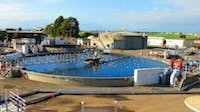Developing accurate flow rate data allows wastewater treatment facilities to more precisely manage digester production levels, enabling tighter controls on methane levels and flaring. This can make facilities more efficient in meeting peak flow and load conditions, which vary based on population changes or wastewater sources.
It is also important to monitor the gas coming out of the digester to ensure the digester health levels are optimally maintained and that greenhouse gas emissions can be accurately reported.
A sensor used to monitor the biogas output can provide an indicator to efficiency of the digester. Gas production is one of the best measures of the progress of digestion. Total biogas production is estimated from the percentage of volatile solids reduction.
However, gas production can fluctuate over a wide range, depending on the volatile solids content of the sludge and the activity of the bacteria in the digester. In addition, excessive gas production rates sometimes occur during startup that can cause gas to escape.
Wastewater facilities have had few choices for obtaining accurate flow measurements in a wet gas environment. Thermal mass flowmeters provide excellent measurement capabilities in dry gas flows; however, they are traditionally sensitive to liquid droplets in the gas stream. As a result of this deficiency, measurements with conventional thermal meters are largely ignored when there is moisture in the gas stream because there is no confidence in the measurements.
Applying Thermal Technology
Mike Spowhn, a consultant with 25 years of experience in the wastewater industry, knew of advancements made in thermal mass technology that make it a cost-effective alternative to ultrasonic technology, the primary choice in wet gas applications.
One of Spowhn’s current projects is with the San Leandro Wastewater Treatment Plant, which has a design capacity of 33 million gal per day (mgd) supporting 85,000 residents, and includes farms and commercial industries among its thousands of businesses. The plant is undergoing major reconstruction to modernize processes for its average influent flow of 5 mgd, while supporting spikes up to 23 mgd. The plant includes primary and secondary treatment processes, and chlorine disinfection. The plant has three 110 kW engines that run on methane to produce electricity and heat.
Consistent Results
Product comparison tests performed over several months at the San Leandro and other wastewater plants demonstrated that the Kurz WGF flowmeter is the only thermal meter capable of consistently and accurately tracking the dry gas in a wet gas environment.
By improving digester management, wastewater facilities have the opportunity to improve their efficiency and decrease operation costs.
- • Accurate digester measurements can show indications of digester imbalances, enabling early corrective action and leading to increased gas production.
- • Optimizing the digester process allows a facility to recover maximum digester gas because correlations can be made between gas production and sludge feeding.
- • Monitoring the true gas flow can facilitate less gas being diverted to the flare and more directed toward recovery processes.
- • Engines can be properly sized for facilities, and managing the engines can be more accurately controlled.
- • Monitoring the gas coming out of the digester ensures that greenhouse gas emissions are reported with lower and more accurate numbers because you can match gas production with gas usage.
The San Leandro plant is very pleased that Kurz Instruments provides a single source for one of the many technologies they’re implementing as a performance indicator - one that also improves efficiency, increases reporting capability, and saves money.
Robert Morpeth is a technical writer for Kurz Instruments. Morpeth can be reached at [email protected] or 800.424.7356, ext. 333.



